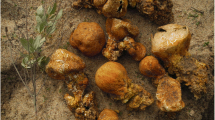Abstract
Sclerotia ofCorticium olivascens are reported and described for the first time. Examples include sclerotia collected from a stump ofPinus virginiana in Greenbelt, Maryland, and those formed in several cultures originally developed from spores produced by basidiocarps. Among outstanding characteristics of basidiocarps ofC. olivascens are the greenish or olivaceous color of the hymenial surface, constant presence of clamp-connections, development of septate cystidia, and production of nonamyloid but dextrinoid basidiospores. Cultural characteristics are described, and the negative oxidase reaction is noted.C. olivascens is a highly distinctive fungus which requires further taxonomic attention.
Zusammenfassung
Sclerotia vonCorticium olivascens sind das erste Mal mitgeteilt und beschrieben. Beispiele betrifft Sclerotia, die vom Baumstumpf vonPinus virginiana in Greenbelt, Maryland gesammelt worden sind und diejenigen, die sich in mehreren Kulturen, ursprünglich von Sporen der Basidiocarpen entwickelt haben. Unter den besonderen Kennzeichen der Basidiocarpen vonC. olivascens sind die grünliche oder olive Farbe der Hymenialoberfläche, ständiges Vorkommen der Klammerverbindungen, Entwicklung septierter Cystidien und die Produktion von nicht-amyloiden, sondern dextrinoiden Basidiosporen. Kulturkennzeichen sind beschrieben und die negative Oxidasenreaktion ist erwähnt.C. olivascens ist ein hoch distinguierter Pilz, der eine weitere, taxonomische Aufmerksamkeit verlangt.
Similar content being viewed by others
References
Aycock, R. (1966). Stem rot and other diseases caused bySclerotium rolfsii. North Carolina Agric. Expt. Sta. Tech. Bul. 174.
Berkeley, M. J. (1873). Notices of North American fungi.Grevillea 1:177–180.
Burt, E. A. (1917). The Thelephoraceae of North America. VIII. Coniophora.Missouri Bot. Gard. Ann. 4:237–269.
Butler, G. M. (1966). Vegetative structures, p. 83–112. InAinsworth, G. C., &A. S. Sussman, The Fungi. Vol. 2. New York. 805 p.
Christiansen, M. P. (1960). Danish resupinate fungi, Part II. Homobasidiomycetes.Dansk Bot. Arkiv 19, 2:57–388.
Davidson, R. W., W. A. Campbell, &D. J. Blaisdell. (1938). Differentiation of wood-decaying fungi by their reactions on gallic or tannic acid medium.Agric. Res. J. 57:683–695.
Davidson, R. W., W. A. Campbell &D. B. Vaughn. (1942). Fungi causing decay of living oaks in the eastern United States and their cultural identification. U.S.D.A. Tech. Bul. 785. 65 p.
Donk, M. A. (1957). Notes on resupinate hymenomycetes — IV.Fungus 27:1–29.
Eriksson, J. (1958). Studies in the Heterobasidiomycetes and Homobasidiomycetes — Aphyllophorales of Muddus National Park in North Sweden.Bot. Upsalienses Symb. 16, 1:1–172.
Gordee, R. S., &C. L. Porter. (1961). Structure, germination, and physiology of microsclerotia of Verticillium albo-atrum.Mycologia 53:171–182.
Güssow, H. T. (1919). The Canadian tuckahoe.Mycologia 11:104–110.
Hotson, J. W. (1912). Culture studies of fungi producing bulbils and similar propagative bodies.Amer. Acad. Arts Sci. 48, 8:227–306.
Lentz, P. L. (1957). Studies in Coniophora. I. The basidium.Mycologia 49:534–544.
Lyman, G. R. (1907). Culture studies on polymorphism of hymenomycetes.Boston Soc. Nat. Hist. Proc. 33, 4:125–209.
McAlpine, D., &J. G. O. Tepper. (1894). A new Australian stone-making fungus.Roy. Soc. Victoria Proc. 7:166–168.
Massee, G. (1889). A monograph of the Thelephoreae. Part. I.Linnean Soc. Bot. J. 25:107–156.
Nobles, M. K. (1958). A rapid test for extracellular oxidase in cultures of wood-inhabiting hymenomycetes.Canad. J. Bot. 36:91–99.
Remsberg, R. E. (1940). Studies in the genus Typhula.Mycologia 32:52–96.
Ridgway, R. (1912). Color Standards and Color Nomenclature. Washington. 43 p.
Vanterpool, T. C., &R. Macrae. (1951). Notes on the Canadian tuckahoe, Its occurrence in Canada and the interfertility of its perfect stage,Polyporus tuberaster Jacq. ex.Fr. Canad. J. Bot. 29:147–157.
Weber, G. F. (1929). Occurrence of tuckahoes and Poria cocos in Florida.Mycologia 21:113–130.
Wolf, F. A. (1922). The fruiting stage of the tuckahoe, Pachyma cocos.Elisha Mitchell. Sci. Soc. J. 38:127–137.
Author information
Authors and Affiliations
Rights and permissions
About this article
Cite this article
Lentz, P.L., McKay, H.H. Sclerotial formation in Corticium olivascens and other hymenomycetes. Mycopathologia et Mycologia Applicata 40, 1–13 (1970). https://doi.org/10.1007/BF02128659
Accepted:
Issue Date:
DOI: https://doi.org/10.1007/BF02128659




